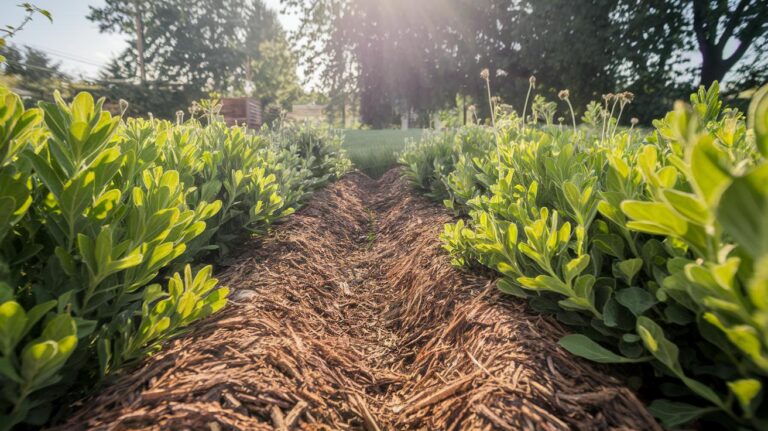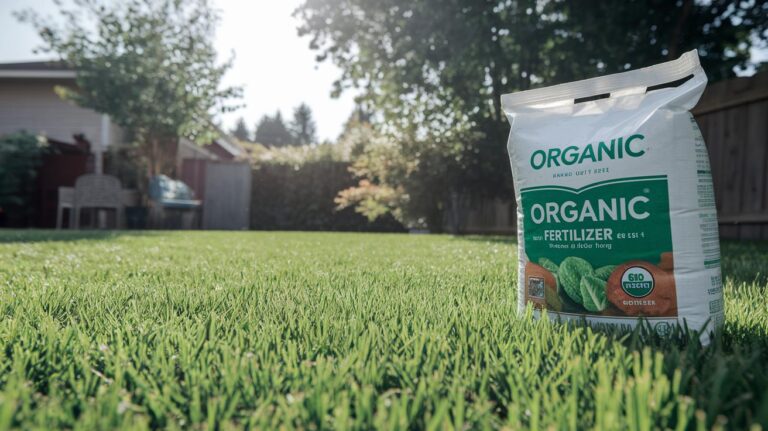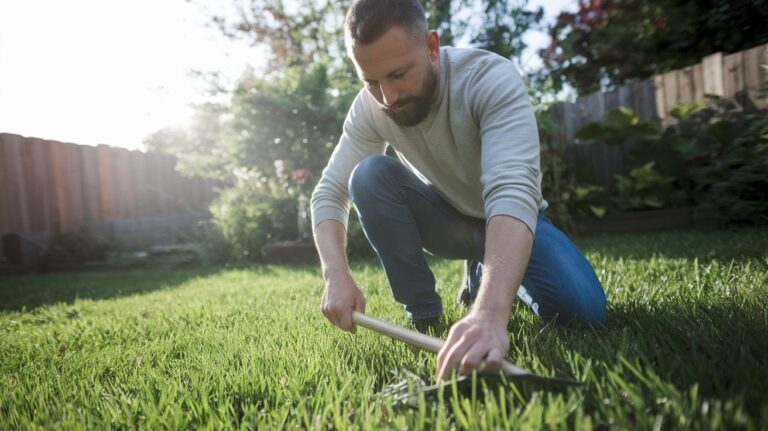Organic Weed Control Methods For Vegetable Gardens Proven
Got a garden choked with weeds? You might think chemicals are your only fix. What if a handful of straw mulch (dried plant stalks that cover the soil), a quick weekly weed-pull, and an autumn buckwheat cover crop (fast plants that protect and feed your soil) could keep your veggie beds weed-free, without harming earth or veggies?
Have you ever smelled fresh mulch on a morning breeze? These three natural tricks quietly proved themselves in my backyard. They block the sun like a cozy blanket, smother tiny sprouts, and sneak fresh nutrients into the warm earth. And each fits right into your routine, no heavy lifting needed.
In this post, I’ll show you exactly how to spread straw mulch, pull weeds by hand, and sow buckwheat step by step. Your carrots and tomatoes will get to shine, healthy and happy, free of weeds and nasty chemicals. Let’s dig in!
Quick-Start Organic Weed Control Guide for Vegetable Gardens
Organic weed control is all about keeping your soil alive and your veggies free of chemical leftovers. Here are three fast tricks to tackle weeds the natural way. You’ll follow earth-friendly steps and even invite helpful bugs into your garden.
-
3-inch straw mulch (dried stalks covering soil)
- When: Right after you clear spring beds and the dirt is dry.
- What you need: Clean straw (not hay), spread in a 3-inch layer, with no seeds.
- Why it’s great (and not so great): It blocks sunlight and keeps moisture locked in, your soil will feel cool and damp. But heavy rain can wash it away, you’ll need to top it up, and tiny seedlings might stay in the shade.
-
Weekly hand-pulling of young weeds
- When: Every 7 days or just after rain, while weeds are small.
- What you need: Gardening gloves, a hand weeder (tool for digging out roots), and a kneeling pad.
- Why it’s great (and not so great): You get rid of roots cleanly without disturbing your veggies. But your arms and legs might feel the burn.
-
Fall buckwheat cover crop (quick-growing soil guard)
- When: Sow 6 to 8 weeks before the first frost so it outgrows late-season weeds.
- What you need: 50 lbs of buckwheat seeds per acre and a seed spreader.
- Why it’s great (and not so great): It smothers stubborn weeds and adds organic matter (decayed plant bits) to enrich your beds. You’ll have to mow it before planting, and friendly pollinators may drop by.
Planting now sets you up for a calmer summer harvest.
By the way, my cat loves sunning on the mulch in fall.
See the next sections for detailed how-tos, extra natural weed-fighting ideas, and non-toxic weed killer options.
Manual Weeding Techniques and Tools for Vegetable Gardens
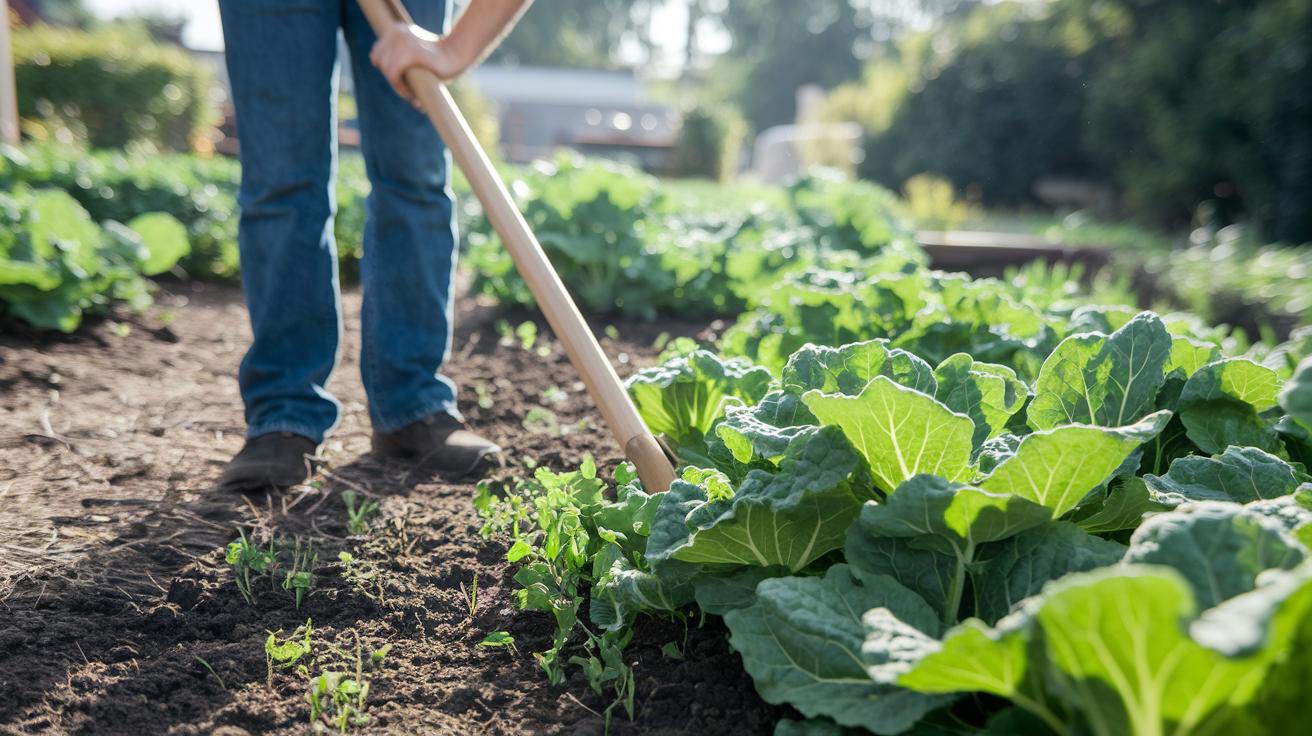
Manual weeding is like a quiet ritual. I love the feel of warm earth crumbling between my fingers as I free a stubborn weed. And you know, pulling by hand means you barely disturb the soil sponge (soil that soaks up water like a sponge) under your veggies.
Best times to weed? Early spring, before those weeds drop seeds. A midseason check to tidy up. And a late fall sweep to catch any stragglers.
Tools to keep handy:
- Stirrup hoe (a U-shaped blade) slices just under the soil skin (top layer) to nip tiny weeds.
- Oscillating hoe uses a smooth push-pull sweep to cut roots without flipping earth.
- Cape Cod weeder (a long metal hook) slips between baby lettuce rows.
- Hand rake loosens the topsoil gently so roots slip free.
- Stand-up weed puller grips taproots while you stay upright, great for your back.
Have you ever felt a chore turn peaceful? That’s weeding done right.
Step by step:
- Walk each row and spot soft baby weeds.
- Fluff the dirt around them with your rake or hoe. You’ll see the soil break apart.
- Grab the stem close to the ground. Pull straight up, steady and firm until the roots let go.
- Scan the hole for any root bits. Even a small piece left can sprout again.
Why go manual?
It’s precise. Kind to the soil. And zero chemicals.
But heads up: it’s a bit of a workout. Big beds can feel slow.
Weed hacks for the usual suspects:
- Dandelion: its taproot dives deep. Use a rake tine (prong) to dig down and pull it out.
- Bindweed: it winds around roots. Twist a stick around the vine and pull with a twist to free the root.
- Chickweed: it seeds fast. Rake a thin layer to smother seedlings, then bag them before they bloom.
Oops, spilled my trowel there. Back to the garden…
Mulching Methods for Suppressing Weeds in Vegetable Gardens
Mulch feels like a soft quilt over your veggie beds, keeping those pesky sprouts from sneaking up to the light. You can use straw (dried stalks from grains), wood chips (small wood and bark pieces), grass clippings (freshly mown lawn bits), shredded leaves (decayed leaves) or even layers of cardboard (recycled paper sheets). Each one blocks sunlight, locks in moisture and keeps the soil (the loose ground you plant in) comfy all season.
First, pull any weeds you see and rake the ground until it’s smooth, like spreading peanut butter on bread. If you want extra backup, lay down newspaper (old newsprint) or a cardboard underlayer. Oops, once I forgot that step and had to do a second round. Lesson learned!
Now, spread your mulch about 2–4 inches deep. Think of it as tucking your plants in with a cozy pillow. Keep the mulch about an inch away from each stem so air can move around the base and roots can breathe.
Here’s a quick how-to list:
- Gather your materials: straw, aged wood chips, dry grass clippings, or leaf mold (broken-down leaves).
- Lay your underlayer (newspaper or cardboard) and smooth it flat.
- Spread the mulch evenly, keeping it off the stems.
- Check back in spring or after a heavy rain and add more mulch where it’s thin.
What you’ll love about mulching:
- It blocks sunlight so weed seeds can’t sprout.
- It holds in water, no more dry soil cracking under your fingers.
- It tames temperature swings, so roots stay safe from heat or cold.
A couple of heads-ups:
- Fresh wood chips might suck up nitrogen (a plant nutrient) as they break down.
- Thick grass clippings can hold soggy moisture, hiding slugs or mold.
Rotate your mulch types each year, and your veggie garden will stay neat and thriving. Time to mulch and watch your plants shine!
Cover Cropping Strategies to Outcompete Weeds in Vegetable Gardens
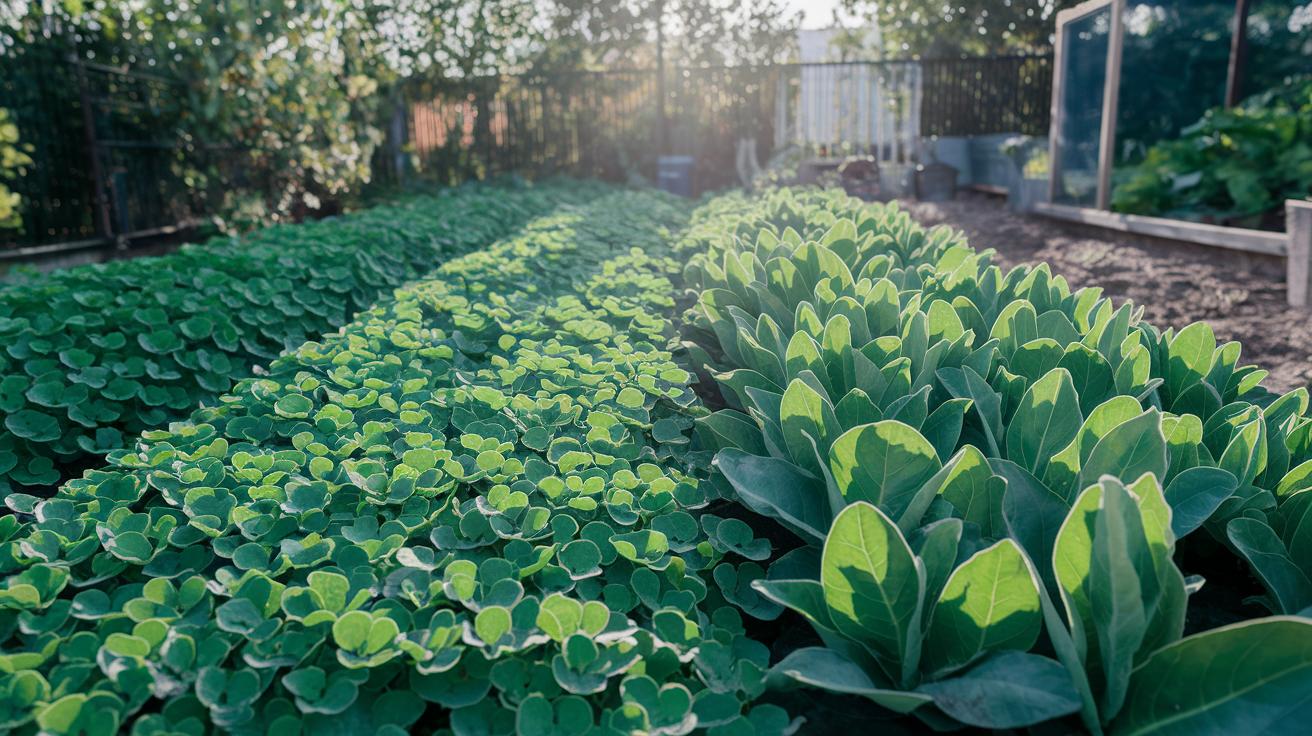
Cover crops give your bare beds a living blanket that smothers weed seedlings before they even peek out of the soil. It’s like nature’s own weed guard, and hey, have you ever felt the soft hum of clover underfoot?
By planting off-season helpers, clover (low-growing legume that adds nitrogen), winter rye (tall grass that holds soil in place), vetch (climbing legume with nitrogen in its root nodules), or buckwheat (fast-growing grain), you leave weeds no room to steal light or nutrients. These leafy green shields also trap soil and cut down on future weed seeds hiding below.
| Cover Crop | Sowing Rate | When to Plant | Key Benefit |
|---|---|---|---|
| Clover (low-growing legume) | 15 lbs per acre | 6–8 weeks before frost | Tight green carpet, nitrogen boost |
| Winter rye (tall grass) | 30 lbs per acre | 4–6 weeks before first freeze | Blocks late weeds, stops erosion |
| Vetch (climbing legume) | 20 lbs per acre | 6 weeks before cold arrives | Covers weeds, stores nitrogen |
| Buckwheat (fast-growing grain) | 50 lbs per acre | 4–8 weeks before veggies | Sprouts fast, cuts off young weeds |
About 1 to 2 weeks before you set your seedlings, mow or roll the cover crop flat. Oops, did I say roll? Either works. Then give it a light till (digging just below the soil surface) to lock in moisture and leave a mulch of chopped plant bits. It’s like laying down a comfy blanket for your new veggies!
- Mow or roll cover crop flat
- Lightly till just below the surface
- Plant seedlings into the chopped-up mulch
And just like that, you’ll have a fresh, weed-light bed ready for summer harvest.
Homemade Organic Herbicide Recipes for Vegetable Gardens
I love pulling weeds, but I don’t love toxic sprays. These homemade herbicides help you zap young weeds with simple pantry ingredients. Mix up your spray, aim at the leaves and come back in a day or two. Tough spots may need a second round.
-
5 to 10 percent vinegar spray
- Mix equal parts white vinegar (that strong sour liquid from your kitchen) and water. Add 1 tablespoon dish soap per quart.
- Use on a sunny day when weeds are under 4 inches tall. Spray only the leaves.
- Pros/Cons: It’s biodegradable and super cheap. But it kills any plant it touches, so keep it off your veggies and flowers.
-
Citrus oil solution
- Stir 2 ounces d-limonene (citrus oil from orange peels) into 1 quart water. Mix in ½ teaspoon soap.
- Spot-treat broadleaf weeds by aiming droplets at the leaf edges. You’ll catch a fresh lemony scent.
- Pros/Cons: Fast burn-down and pleasant scent. But deep-rooted perennials might need several treatments.
-
Clove oil mist
- Shake well before each use: 1 teaspoon clove oil (oil from the clove spice), 1 teaspoon mild soap, and 1 cup water.
- Mist young weed crowns on a still afternoon. Don’t spray when it’s windy or you’ll hit nearby plants.
- Pros/Cons: It zaps weed cells quickly. But overuse can harm helpful soil microbes.
-
Horticultural oil spray
- Blend 2 tablespoons horticultural oil (a plant oil that smothers pests) with 1 teaspoon soap in 1 gallon water.
- Coat weed surfaces fully. Wait 2 to 3 hours before watering so it can settle in.
- Pros/Cons: It suffocates seedlings fast. Repeat weekly until sprouts give up.
Safety tips:
- Always wear gloves and eye protection. I once forgot goggles and got soap in my eyes, ouch!
- Use a shielded sprayer or a nozzle attachment to keep your veggies safe.
- Test on a small patch first to avoid any surprise damage.
Since these sprays don’t pick and choose, handle them with care. For more on using nonselective sprays safely, peek at how to kill weeds naturally in lawn without chemicals.
Now grab your spray bottle, face the sun and watch those weeds wilt. Good luck in your garden!
Cultural Practices: Plant Spacing and Precise Irrigation for Weed Reduction
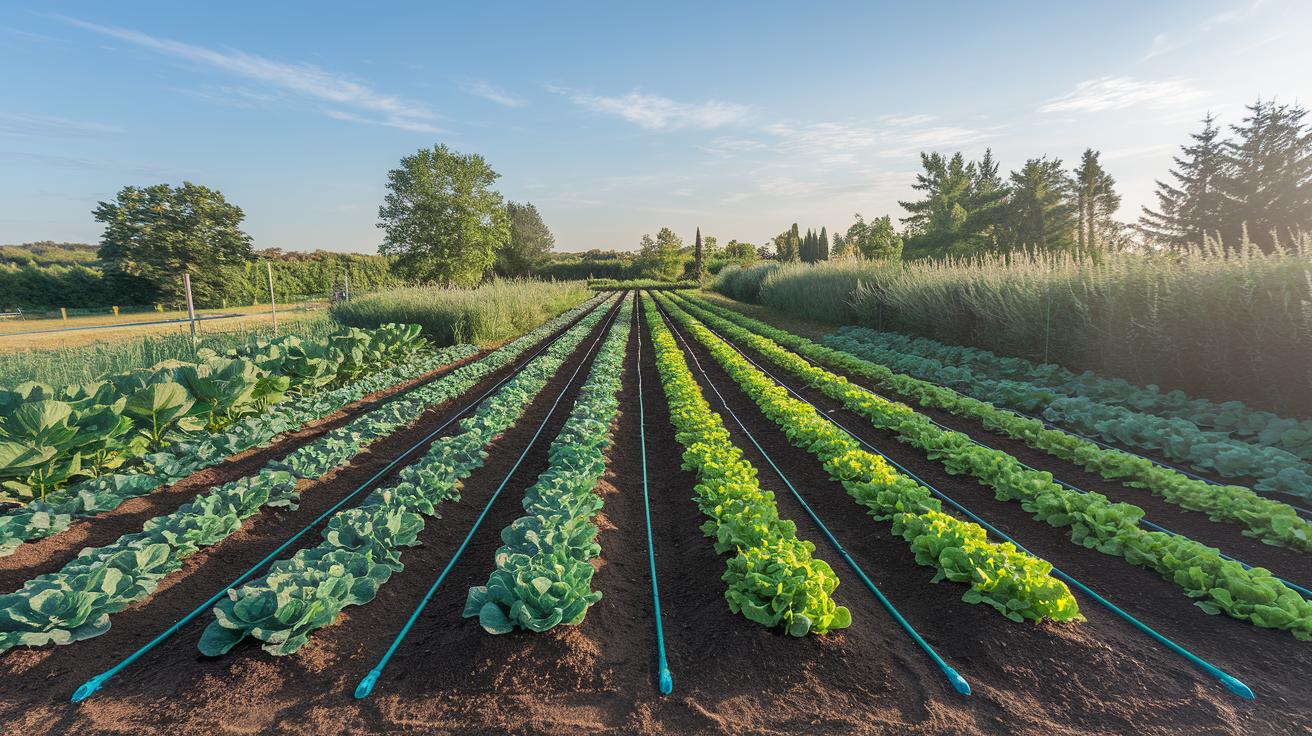
Give your veggies some breathing room and just a sip of water at their roots. When leaves brush together overhead, they cast a little umbrella of shade so weed seeds never see the light. And with a drip irrigation system (a slow drip watering setup that sends moisture right to roots), the soil surface stays drier. Weed seeds go thirsty.
Plant Spacing
- Tomatoes: set plants 12 to 24 inches apart so their leaves overlap like a shady roof.
- Lettuce: leave 6 to 12 inches between heads for a leafy canopy that outshades tiny weeds.
- Crowd crops just enough to share shade without smothering each other’s roots.
Drip Irrigation Systems (slow drip watering setup)
- Lay drip tape (thin tubing) every foot along each row for even moisture.
- Use emitters dripping 0.3 to 0.6 gallons per hour and aim right at the root zone.
- Water only when the top inch of soil feels dry. Skip sprinklers that spray everywhere.
Moisture Control Tips
- Flush your lines monthly to clear clogs and keep flow steady.
- Walk the rows weekly to check for drips or dry spots.
- Adjust as plants grow. Seedlings need a gentle sip and fruiting tomatoes need a deeper drink.
Oops. I once skipped a line flush and ended up hunting down a clog for hours. Lesson learned! This combo of smart spacing and targeted watering leaves weeds high and dry while your veggies thrive.
Advanced Pre-Planting Treatments: Soil Solarization and Ground Barriers
Ever wish your veggie patch could start the season weed-free? Soil solarization is like a spa day for your garden beds. It bakes the soil under clear plastic and zaps weed seeds before they even sprout.
Moisten the soil about 8 inches deep (that’s roughly the length of your hand), think of it as giving the dirt a big drink before its sauna.
Lay a clear 1–2 mil plastic sheet over the damp earth and tuck the edges with soil or rocks so no heat escapes.
Let it sunbathe in the hottest months for 4 to 6 weeks. You’re aiming for 110–125 °F, which can shrink weed seed banks by up to 80 percent.
And bonus: this trick also cuts down on fungal pathogens (disease-causing fungi) and nematodes (tiny root-eating worms).
Now let’s add a second shield: ground barriers. I like to use cardboard pieces or 8–10 sheets of newspaper under a light layer of mulch or fabric. These break down over time and turn into organic matter (decayed plant bits that feed soil).
When planting day finally arrives, peel back the plastic and lift off those mats. You’ll see soft, warm earth ready for seeds or seedlings. Chop any softened barrier bits with a hoe or stir them into the top few inches of soil. They’ll act like a slow-release snack for hungry roots.
Plant away in a clean, crumbly bed, no chemicals needed.
Final Words
In the action, we tackled fast-start picks like straw mulch, weekly weed pulling, and buckwheat cover crops, then explored precise manual weeding tools.
We covered mulching layers, cover crops, DIY herbicide recipes, plant spacing with drip irrigation, and hot sunny solarization. Each step is there to fit into busy routines and keep your soil happy.
Mix and match these tactics to trim chores, boost yields, and enjoy a fuss-free plot. Here’s to healthier soil, thriving veggies, and fewer weeds through organic weed control methods for vegetable gardens.
FAQ
What are quick-start organic weed control methods for vegetable gardens?
Quick-start organic weed control methods include applying a 3″ layer of straw mulch, pulling young weeds by hand weekly, and planting a fall buckwheat cover crop to smother new weeds and feed your soil.
How do I manually weed vegetable beds effectively?
Loosen soil around each weed’s base, grip at the crown, and pull out the entire root. Use stirrup or oscillating hoes for deeper roots and tackle patches early.
Which mulch materials work best to suppress weeds in a veggie garden?
Effective mulch materials are straw, wood chips, grass clippings, shredded leaves, or cardboard underlay. Spread a 2–4″ layer above cleared soil, keep mulch 1″ away from stems, and refresh yearly.
How do cover crops help control weeds in vegetable gardens?
Cover crops like clover, winter rye, vetch, or buckwheat outcompete weeds by shading seedlings and using nutrients. Sow 4–8 weeks before frost, then mow or lightly till 1–2 weeks before planting veggies.
How can I make a homemade organic herbicide for my vegetable garden?
Mix equal parts 5–10% vinegar with water and add 1 tablespoon of dish soap per quart. Spot-spray young weeds on sunny days and avoid touching edible leaves.
How does plant spacing and targeted irrigation reduce weed growth in veggie beds?
Optimized plant spacing (12–24″ for tomatoes, 6–12″ for lettuce) shades soil and limits weed sprouts. Drip irrigation delivers water only at roots, starving weed seeds on the soil surface and saving water.
What is soil solarization and how can I use it to kill weed seeds?
Soil solarization uses clear plastic sheets to trap heat and bake weed seeds. Moisten soil, seal edges of 1–2 mil plastic for 4–6 weeks in summer, then remove plastic and mix softened barrier into soil before planting.




